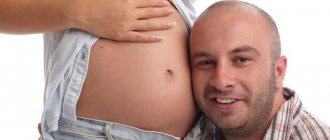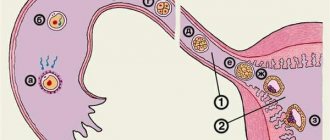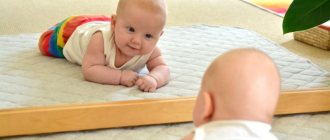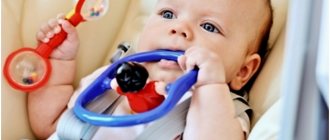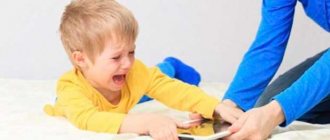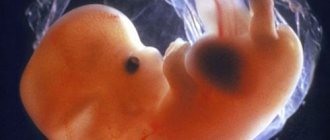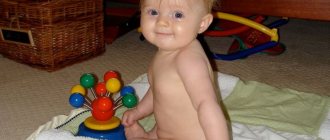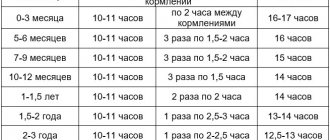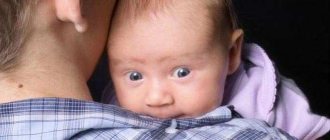What is a cough
Coughing is a way to clear the airways, the mucous membranes of which can be irritated by dust, sputum, and microorganisms. This is a defense that occurs reflexively. The cough is designed to help get rid of anything that is disrupting your breathing. The same applies to small parts of toys, buttons and paper clips that end up in children’s throats. If the baby manages to cough, the small object will leave the respiratory tract, and there will be no need to visit an ENT specialist. Noticing a foreign body is not always easy, especially if the child is not yet speaking. Therefore, during games you need to watch the baby.
Note! A cough can accompany an infectious disease, acute inflammation, or be a symptom that requires independent treatment.
How to treat a baby’s cough in the future
If you are going to cure a cough, you need to show the baby to the pediatrician. After the examination, the specialist will determine whether therapy is necessary (if so, he will prescribe medications) or whether the cough is not dangerous and will go away on its own.
Antitussives
Medicines from the group of antitussives (Butamirat, Sinekod) are prescribed only if coughing attacks are repeated frequently and exhaust the child. When treating a dry cough, antitussives are used for 3-4 days (longer only for whooping cough).
In parallel with drugs that suppress the excitation of the cough center, No-Shpu or another antispasmodic is prescribed, which reduces the likelihood of bronchospasm.
Expectorants and mucolytics
When a cough without fever becomes productive (usually on days 3-4), doctors recommend syrups and drops that dilute mucus and stimulate its excretion. Herbal remedies - Eucabal, Gedelix, Taisa syrup - help treat wet cough in infants. Mucolytics (Fluditek, Ambroxol) are given to babies only as prescribed by a doctor.
Rubbing
The baby cannot cough or spit out mucus on its own.
To help your baby clear his airways at normal body temperature, doctors recommend lightly rubbing the chest in a circular motion.
Starting from the 6th month of life, warming ointments Eucabal, Doctor IOM can be used to treat cough, but only on the recommendation of a pediatrician.
Creating comfortable conditions
It often happens that a cough does not go away for a long time even though the baby is healthy and has a normal temperature. Daily walks in a place where the air is not polluted by exhaust gases or dust will help get rid of this unpleasant symptom. The children's room must be ventilated several times a day and wet cleaning done daily.
It is extremely important that the air in the house is not too warm (no higher than 20°C) or dry.
How to treat a cough in an infant with massage
In the case of a wet cough in a 1-month-old child or older, massage of the chest and back is effective. The procedure is done if the baby has a normal temperature, twice a day, an hour after meals.
With warm palms, gently rub the sternum and rib area (also on the side). When the skin turns slightly pink, lightly pat with palms cupped and tap with fingertips. Then the baby is turned over with his back up and the same movements are repeated. At the end of the massage, the baby is placed so that his legs are slightly higher than his head - this is necessary so that the mucus comes out more easily.
Folk remedies
Doctors recommend treating a baby’s cough with folk remedies extremely carefully, and for up to 6 months, abandoning them completely.
Older children can get rid of a cough without a fever using potato cakes on their chest and warming with warm salt (the bags are applied to the feet).
Herbal teas for children older than six months should be prepared from one plant - thyme, chamomile, plantain. To prepare the drink 1 dess. A spoonful of dry raw materials is poured with 200 ml of boiling water. Leave for 30-40 minutes. Strain, give to drink warm half an hour before meals 3-4 times a day, 1 tbsp. spoon.
Why does a child cough when he cries?
When a child cries, the amount of mucous secretions that accumulate in the nasopharynx increases. They begin to flow down the back of the throat and irritate the receptors. The latter are also found in the nose, larynx, trachea and bronchi. As a result, a cough begins. With the help of an unconditioned reflex, the body tries to get rid of excess mucus that interferes with the passage of air.
Newborns often have a physiological runny nose; nothing needs to be done about it; it goes away on its own with age. When crying, there is even more mucus, and the child may cough.
In some babies, excessive crying leads to vomiting. Excess tears and mucus act on the soft palate, irritating it. If the muscles are weak, the baby may vomit. Then it is important to be close to the baby, tilt his head forward. If a child vomits, there is a risk that he will choke on the vomit. As soon as the baby calms down and stops crying, he needs to be washed with cool water.
A child may cough when crying if his nervous system is at its limit:
Cough while crying in a child
A child's cough while crying always causes serious concern for parents. Panic manifests itself in conviction: crying means you are sick. He's sick, that's why he's coughing. In our article we will look at what a cough is and why it appears when a child sobs.
What is a cough
Cough is a reflex release of the bronchi from dust, mucus, and foreign particles. It performs a healing function, rids the bronchi of pathogenic bacteria. This is not always a sign of a cold, viral or chronic disease.
For example, a cough also appears in a healthy child while crying. The reason is that the baby's nasopharynx becomes clogged with mucous secretions.
Excess tears enter the nasopharynx. Congestion from the nose flows down the back of the throat, stimulating the cough reflex. Similar symptoms appear in children aged three to seven years.
Learn about ways to treat coughs due to sinusitis.
Sometimes, while crying, the child begins not only to cough, but also to vomit.
Vomiting occurs during crying for the same reasons as coughing. The nasal ducts are freed from excess fluid, but tears and mucus do not come out through sneezing, but slide down the back wall of the nasopharynx, irritate the soft palate and cause vomiting after coughing.
Carefully! If a child vomits while crying, tilt him face down, otherwise the baby will choke. Wait until the vomiting stops, wash the child with cool water, and give him something to drink. This will stop the sobbing and eliminate stomach cramps.
Reasons and ways to deal with the problem
First of all, find out if there are any signs of an emerging disease: respiratory viral infections, colds. Pay attention to how your baby is feeling at night. The onset of the disease is signaled by a night cough. If it is not present at night, it means that the baby does not have an infectious or cold disease.
Attention! If a cough occurs at night, consult your child’s pediatrician. Quick diagnosis of the disease facilitates further treatment.
First of all, find out the reason for crying and try not to create conditions for the emergence of negative emotions, and also follow the recommendations:
- When crying and vomiting, the water-salt balance is disturbed. Give your child clean water to drink in small quantities. You can add five drops of chamomile or anise infusion to the water. The drink has a calming effect and eliminates the effects of coughing and vomiting.
- Conduct classes with your child on hardening the soft palate . To do this, apply gentle pressure on it every day with a soft toothbrush or spoon. This training will reduce the sensitivity of the palate, and there will be less gagging when coughing.
- Use your child's mouth rinse . This simple procedure to carry out at home will prevent unwanted nasopharyngeal reflexes.
- Daily rinses can be done with weak solutions acidified with lemon juice. Acidic solutions will relieve excessive dry mouth, which also causes coughing while crying.
- The reason for crying followed by coughing and vomiting often lies in the stress that the child experiences when parents quarrel, for example, or from lack of attention. Excessive attention from parents also leads to undesirable consequences - the whims of the baby. Maintain smooth, friendly relationships in the family.
- Harden the baby's nervous system: warm baths at night with sea salt solutions, morning rubdowns with cold water will have a beneficial effect.
- Exercising the muscles of a child's tummy also helps to get rid of gagging when coughing.
If you see that the child is gagging and continues to cry and cough, ask him to clench his left fist. This will stop the vomiting. Then distract the baby’s attention, offer to play or take a walk.
Find out how to get rid of purulent sputum when you cough.
Conclusion
Baby crying that causes coughing and vomiting has various causes. Parents will need attention and patience to identify and eliminate the cause. This could be overwork, fear, discomfort, nervous breakdown. If it is detected, be sure to consult a doctor; self-medication in this case is excluded.
At the same time, we should not forget that crying is a natural expression of emotions. But emotions cannot be prohibited. The more tender and emotional your baby is, the faster he can cry, but the easier it is to distract him from sad thoughts, offer him a game, and make him laugh. If there are obvious signs of the disease, the help of a medical practitioner will be required.
When she cries, she starts coughing a lot
Dear mothers, when my child cries, he starts coughing a lot, why does this happen? Has anyone had this happen? The question was asked by Khava Dokaeva
Please tell me who had this situation and how it all ended We are 11
by Adminrive · Published 06/03/2014
Source: https://kokch.ru/kashel-vo-vremja-placha-u-rebenka/
Tips for mom
Parents should monitor the baby’s well-being if he develops a cough:
If the child’s condition and mood remain the same, and there are no additional symptoms, then you need to try not to make the baby hysterical. As soon as the child starts crying, distract him and switch his attention. If you quickly calm him down, you can most likely avoid another coughing attack.
To avoid overexcitement of the baby and reduce the risk that he will cough when crying, you need to take care of his routine:
Children under one year of age are most susceptible to the mood of their parents. If the mother is upset or irritable, the baby feels it and begins to worry, copying her emotions. It is important to take care of a favorable climate in the family.
Treatment of cough in infants
You need to contact a specialist. A doctor who examines and treats newborns is a neonatologist. A pediatrician cares for babies older than one month.
Actions for a runny nose during ARVI
In this case, the baby’s nose should be washed with an antiseptic solution. The best option is drops. Then, using a rubber bulb, the contents of each nasal cavity are removed in turn.
Advice! During this unpleasant procedure, it is necessary to close the entrance to the baby’s ear with your finger to prevent mucus from entering the ear cavity behind the pressure gradient. In this way, you will prevent the development of otitis media.
If the air in the room is dry
Simple ways to increase air humidity in your home:
- If it is cool outside, it is enough to open the window in the room for a short time.
- Place a bowl of water near the hot radiator . You can make a simple device from a plastic bottle and secure it in a warm place. The water will evaporate and the climate in the room will improve significantly.
- Shake the wet towel several times.
- Hang wet bedding around the perimeter of the room.
When the cause of cough is confirmed bronchial asthma or bronchitis, the doctor prescribes inhalation of saline solution, bronchodilators (bronchodilators) through a nebulizer - a modern device for converting liquid into fine particles that easily enter even the most distant and narrow branches of the bronchial tree.
Instructions for pulmicort:
- The active substance is budesonide.
- Group of drugs: hormonal bronchodilator.
Pulmicort is a drug that dilates the bronchi.
- The effect occurs 1 hour after administration, but lasts a long time.
- Release form: suspension for inhalation, 0.25 ml/kg.
- Indication: bronchial asthma.
- Price: about 400 UAH.
- for babies under 6 months, with caution and according to strict indications - 0.25 mg/kg/day, diluted with 0.9% saline before use;
- children over 6 months – 0.25-0.5 mg/kg/day.
Advice! The solution for inhalation must be prepared strictly according to the instructions and used within 30 minutes.
If there is no nebulizer at home, use inhalations (see How to carry out inhalations for a dry cough at home) over a bowl of steaming tea made from rose hips, sage herb or chamomile flowers. The method is cheap but effective. Dried plants cost pennies in pharmacies, and do not cause side effects when used in moderation.
Mucolytics - medications that reduce the viscosity of sputum - help turn a dry cough into a wet one.
Is it dangerous if a baby coughs?
If a newborn coughs while crying, there is usually nothing to worry about. The main thing is that the child’s temperature does not rise and his behavior does not change.
Note! Do not be afraid of coughing, because it also has a healing function, helping to restore breathing. It gets rid of phlegm, the accumulation of which, combined with being in a stuffy room, can provoke bronchitis and pneumonia.
First of all, the presence of the disease must be excluded in the newborn. Even if a child is fed breast milk, which strengthens his immune system, there is a risk of contracting a viral infection. Therefore, it will never be a bad idea to consult a pediatrician.
If a child cries when coughing, he is most likely in pain. Then he may refuse to eat, because he experiences discomfort when swallowing food. This is especially dangerous for a newborn, because in the first weeks after birth, nutrition is the basis of a baby’s life.
When to call a doctor
If a child starts coughing after crying, you should visit a pediatrician in the following cases:
Weepy and lethargic baby
Note! Infectious diseases are not always accompanied by fever. A cough that appears while crying may be the first symptom. You should not ignore such signs, especially if the baby is not yet 3 months old.
When a child coughs and cries, you need to find out why this is happening. This is usually due to an increase in the volume of mucus running down the back of the throat. Coughing occurs as a reflex; the body reacts to everything that makes breathing difficult. If additional symptoms appear that are noticeable at rest, you should consult your pediatrician.
What is a cough
Coughing is a way to clear the airways, the mucous membranes of which can be irritated by dust, sputum, and microorganisms. This is a defense that occurs reflexively. The cough is designed to help get rid of anything that is disrupting your breathing. The same applies to small parts of toys, buttons and paper clips that end up in children’s throats. If the baby manages to cough, the small object will leave the respiratory tract, and there will be no need to visit an ENT specialist. Noticing a foreign body is not always easy, especially if the child is not yet speaking. Therefore, during games you need to watch the baby.
Note! A cough can accompany an infectious disease, acute inflammation, or be a symptom that requires independent treatment.
Why does a child cough when he cries?
When a child cries, the amount of mucous secretions that accumulate in the nasopharynx increases. They begin to flow down the back of the throat and irritate the receptors. The latter are also found in the nose, larynx, trachea and bronchi. As a result, a cough begins. With the help of an unconditioned reflex, the body tries to get rid of excess mucus that interferes with the passage of air.
Newborns often have a physiological runny nose; nothing needs to be done about it; it goes away on its own with age. When crying, there is even more mucus, and the child may cough.
In some babies, excessive crying leads to vomiting. Excess tears and mucus act on the soft palate, irritating it. If the muscles are weak, the baby may vomit. Then it is important to be close to the baby, tilt his head forward. If a child vomits, there is a risk that he will choke on the vomit. As soon as the baby calms down and stops crying, he needs to be washed with cool water.
A child may cough when crying if his nervous system is at its limit:
How to prevent and calm a cough
Even if a child coughs for natural reasons not related to respiratory or other diseases, in most cases this reflex can be stopped or weakened.
Methods that can calm a cough:
- Frequent ventilation;
- Preventing high indoor temperatures and keeping them stable throughout the day;
- Humidifying the air in the room where the child sleeps;
- Place a slightly higher pillow when your baby falls asleep. This helps partially clear the airways;
- Let the baby drink more. This is especially useful for productive coughs, as it helps to liquefy bronchial secretions and facilitate their removal;
- If there is mucus, you should rinse your nose with saline several times a day;
- Avoid exposure to tobacco smoke;
- In the case of an allergic cough, you need to find out what can provoke it and eliminate dangerous factors: indoor plants, pets, etc.;
- It is necessary to regularly wipe off dust and wash the floor, avoiding the use of household chemicals.
Important ! Herbal antitussive infusions are not recommended for infants, as their components can provoke allergic reactions.
A good way to speed up the discharge of sputum during a productive cough in infants over three months of age is drainage massage. It is done a few days after the cough starts. Approximate procedure:
- Warm or rub your palms so that they are warm, lubricate the baby's skin with baby cream;
- Place the baby on his tummy, the position should be slightly tilted down towards the head;
Performing drainage massage
- Rub the baby's back, gently pressing with your fingers. Direction – from the waist to the shoulders. Then turn the baby over and stroke your hands towards the neck in the central part of the chest. The skin should turn slightly red;
- Massage for 10 minutes twice a day. After the massage, wrap the child in a blanket and put him to sleep.
Important! You should start the massage half an hour after eating, otherwise you can provoke vomiting.
Most often, a cough in infants without fever is not dangerous, but if it is prolonged or repeated very often, then the situation must be kept under control. In some cases, cough may be a symptom of developing diseases.
Tips for mom
Parents should monitor the baby’s well-being if he develops a cough:
If the child’s condition and mood remain the same, and there are no additional symptoms, then you need to try not to make the baby hysterical. As soon as the child starts crying, distract him and switch his attention. If you quickly calm him down, you can most likely avoid another coughing attack.
To avoid overexcitement of the baby and reduce the risk that he will cough when crying, you need to take care of his routine:
Children under one year of age are most susceptible to the mood of their parents. If the mother is upset or irritable, the baby feels it and begins to worry, copying her emotions. It is important to take care of a favorable climate in the family.
Is it dangerous if a baby coughs?
If a newborn coughs while crying, there is usually nothing to worry about. The main thing is that the child’s temperature does not rise and his behavior does not change.
Note! Do not be afraid of coughing, because it also has a healing function, helping to restore breathing. It gets rid of phlegm, the accumulation of which, combined with being in a stuffy room, can provoke bronchitis and pneumonia.
First of all, the presence of the disease must be excluded in the newborn. Even if a child is fed breast milk, which strengthens his immune system, there is a risk of contracting a viral infection. Therefore, it will never be a bad idea to consult a pediatrician.
If a child cries when coughing, he is most likely in pain. Then he may refuse to eat, because he experiences discomfort when swallowing food. This is especially dangerous for a newborn, because in the first weeks after birth, nutrition is the basis of a baby’s life.
When to call a doctor
If a child starts coughing after crying, you should visit a pediatrician in the following cases:
Weepy and lethargic baby
Note! Infectious diseases are not always accompanied by fever. A cough that appears while crying may be the first symptom. You should not ignore such signs, especially if the baby is not yet 3 months old.
When a child coughs and cries, you need to find out why this is happening. This is usually due to an increase in the volume of mucus running down the back of the throat. Coughing occurs as a reflex; the body reacts to everything that makes breathing difficult. If additional symptoms appear that are noticeable at rest, you should consult your pediatrician.
What is a cough
Cough is a reflex release of the bronchi from dust, mucus, and foreign particles. It performs a healing function, rids the bronchi of pathogenic bacteria. This is not always a sign of a cold, viral or chronic disease.
For example, a cough also appears in a healthy child while crying. The reason is that the baby's nasopharynx becomes clogged with mucous secretions.
Excess tears enter the nasopharynx. Congestion from the nose flows down the back of the throat, stimulating the cough reflex. Similar symptoms appear in children aged three to seven years.
How to treat adenoids in a child at home?
Learn about ways to treat coughs due to sinusitis.
Sometimes, while crying, the child begins not only to cough, but also to vomit.
Vomiting occurs during crying for the same reasons as coughing. The nasal ducts are freed from excess fluid, but tears and mucus do not come out through sneezing, but slide down the back wall of the nasopharynx, irritate the soft palate and cause vomiting after coughing.
Carefully! If a child vomits while crying, tilt him face down, otherwise the baby will choke. Wait until the vomiting stops, wash the child with cool water, and give him something to drink. This will stop the sobbing and eliminate stomach cramps.
Cough to the point of vomiting in children - causes
Vomiting can follow a debilitating dry cough that does not leave you alone even at night.
The fact is that during the process of coughing phlegm should come out, but this does not happen. So, the cough does not stop for a long time, which is why the child will simply start vomiting. Every parent knows that stopping this process is extremely difficult.
A dry cough in itself is not the best sign. The inability to discharge sputum should alert you, as this indicates the rapid development of the inflammatory process in the respiratory organs.
But do not think that only a dry cough provokes vomiting. In babies, it can even occur against the background of a wet cough, but in this case, the discharge of sputum is a good sign.
But there are other reasons for vomiting due to coughing:
The indoor air is too dry. The lack of the required concentration of moisture in the air dries out the mucous membrane of the larynx, which causes a sore throat. This problem arises precisely during the heating season, so parents often confuse such a harmless cough with serious illnesses.
Hypothermia of the body, followed by the development of a cold. If it happened that the child was in the cold for some time, then a cold will certainly not keep itself waiting. By the evening, the child will have a fever, accompanied by snot and pain in the head. This reason is quite understandable and common, so there is no need to worry too much. The main thing is to start timely treatment.
Nasal mucus getting into the throat. If nothing bothered the child except a runny nose, and after some time a cough appeared, then it was the mucus from the nose that provoked it. Older children swallow the liquid that flows down their throats, but infants cannot do this yet, so they simply cough it up.
Bronchial asthma appears in the form of attacks , so it is quite easy to recognize it. The child experiences difficulty breathing caused by spasms of the bronchial tissue. By coughing, the body tries to prevent the respiratory passage from being blocked in order to at least somehow breathe.
Allergies are usually accompanied not only by rashes, but also by swelling of tissues, both internal and external. Due to swelling of the internal organs, the airways are also blocked, which is why the child simply cannot breathe. Here, parents will be able to immediately understand what’s going on and quickly find their bearings by calling an ambulance.
Reflux disease is caused by irritation of the larynx with stomach contents that enter the esophagus. Thus, irritation of tissues leads to their drying out, and hence to coughing. This symptom appears mainly when the baby is in a lying position.
Penetration of infection into the body. These can be not only the classic manifestations of measles or whooping cough, but also the consequences of ARVI. This can be either bronchitis or pneumonia, but they only occur if the disease is ignored. Only a doctor who can prescribe the correct treatment can determine the cause.
In addition to the above prerequisites, there is another, most terrible cause of dry cough with vomiting - tumors in the lungs.
This pathology, unfortunately, is not detected immediately, but, nevertheless, it occurs in the early stages of development.
If treatment for a cough does not bring any positive results, but on the contrary, the cough only gets worse, then it is better to immediately inform your pediatrician.
At the same time, the baby may lose appetite, which will lead to a weakening of the immune system.
In addition, traces of blood may be visible in the sputum that the baby managed to cough up. Therefore, the earlier the disease is detected, the more favorable the prognosis will be.
Reasons and ways to deal with the problem
First of all, find out if there are any signs of an emerging disease: respiratory viral infections, colds. Pay attention to how your baby is feeling at night. The onset of the disease is signaled by a night cough. If it is not present at night, it means that the baby does not have an infectious or cold disease.
Attention! If a cough occurs at night, consult your child’s pediatrician. Quick diagnosis of the disease facilitates further treatment.
First of all, find out the reason for crying and try not to create conditions for the emergence of negative emotions, and also follow the recommendations:
If you see that the child is gagging and continues to cry and cough, ask him to clench his left fist. This will stop the vomiting. Then distract the baby’s attention, offer to play or take a walk.
How to cure residual cough in a child?
Find out how to get rid of purulent sputum when you cough.
How to treat a cough with a runny nose in a child?
Cough after laughing, what causes a cough when laughing?
I stole stolen recommendations, so I won’t name the source))))) This is very relevant to me. The child has a runny nose, accompanied by a wet cough, but there is no high fever. In this case, humidify the air in his room by placing a vessel of boiling water in it, to which you can add a few drops of eucalyptus essence. Rinse his nose with physiological serum.
If your cough does not go away, consult your doctor. The child has a hoarse cough, difficulty breathing, and is restless. We may be talking about laryngotracheitis. Keep your child in a sitting position while waiting for the doctor. It is best to stay with him in the bathroom, opening all the hot water taps. The child has a dry cough and wheezing.
This could be bronchitis, pneumonia or an asthma attack. Consult your doctor. How to treat a child's cough? The advertised drugs have become so expensive that it is impossible to get access to them.
Maybe we should remember the advice of our grandmothers: honey compresses, jars, mustard plasters? “It happens that a child complains of a sore throat, and parents immediately begin to treat him with antibiotics and other potent drugs. Is this true? - Of course not. You first need to understand the nature of the cough, the reasons that caused it, and then just think about what pills to take.
If your baby has a dry, obsessive cough, then why give him expectorants? Only when the cough becomes milder, it is felt that the child wants to cough up, but cannot - then expectorants must be administered. But they should not be overused, they can provoke allergies, and the cough will take on a different character.
Therefore, it is very important to know when to stop: if you have a wet cough (with sputum), stop taking the expectorant. If you have a normal sore throat, give your baby something warm to drink more often and give him antihistamines, for example, Suprastin or Claritin. — During the first two weeks, it is almost impossible to distinguish a whooping cough from a cold.
Only in the third or fourth week does it become spasmodic. It looks something like this: the child coughs, and then suddenly a frequent paroxysmal cough begins - the face turns red, the veins in the neck swell, and the baby emits a sound similar to the crow of a rooster.
This may continue for about two weeks, then the cough subsides, but, unfortunately, the child coughs periodically for a long time. Whooping cough sometimes turns into an allergic cough, so you cannot treat this disease on your own; the child must be observed by a pediatrician. For whooping cough, sedatives are usually prescribed.
Walking in the air is very useful, especially near some bodies of water - it calms the cough. - A cold cough is most often dry at first, and then turns into wet. Parents need to pay attention to whether the child clears his throat, whether he produces sputum and what color it is. If the sputum is yellow, then there are signs of an inflammatory process.
This could be bronchitis, laryngotracheitis, etc. Adults should know that it is impossible to suppress a wet cough with the help of medications, because sputum will accumulate in the bronchi and thereby worsen the inflammatory process. Such a cough should be treated with expectorants and massage so that the phlegm can be cleared more easily.
It is better to do a massage with baby cream: knead the baby’s chest and back, rub it properly. Finish the procedure with light stroking. — Inhalations, as well as mustard plasters and cups are acceptable, for example, for a cold cough. For asthmatics and allergy sufferers, such methods are not recommended. For an allergic cough, I would advise doing alkaline inhalations: 1 teaspoon of soda per glass of water.
Pour the solution into a kettle, bring it to a boil, then put a thick paper tube on the spout - the child must breathe this steam. Just remember to be careful so that the baby does not get scalded; one of the adults should always be nearby. You can pour hot alkaline water into a thermos and let your child breathe over it. Soda can be replaced with Borjomi.
Heat mineral water and let the child inhale the steam. This procedure must be done at least in the morning and evening for seven days. It is useful for frequent dry coughs of any origin. This alkaline water also helps in the removal of mucus. Hot foot baths will help with a dry cough, and if you are not allergic, you can add mustard to the water.
I prescribe herbs if they do not cause allergies in the child. I can recommend licorice root, glycyram (extract from licorice root) - it is prescribed for allergic and other types of cough. Decoctions of coltsfoot and plantain leaves, breast collection No. 2, have an expectorant effect.
Many parents consider marshmallow mixture a miracle cure - it has an expectorant and anti-allergic effect. Drink chamomile infusion (a teaspoon per glass of boiling water - brew, let it brew), a dessert spoon 2-3 times a day. 2. In the evening, if there is no temperature, warm the legs in a mustard solution. 3.
You can pour mustard into your socks at night and put them on other socks, i.e. so that the mustard ends up between the socks. 4. At night, apply this compress to the neck area and grab the breast a little - boil the potatoes, remember them and put them in a bag, wrap the bag with a towel and apply it to the neck. It helps a lot. Just make sure that the breast is not covered too much.
This is a good expectorant. The last two points can only be done in the absence of fever. Milk with oats helps very well with coughs and bronchitis. Boil milk and pour it into a thermos, then take oats, always in the husks, and pour them into the milk, about a handful per glass.
The thermos is closed and you can feed the child for 5-6 hours, naturally having first filtered the oats from the milk. If milk sits in a thermos for about 20 hours, it will curdle. To prevent phlegm from settling on the lungs, we performed micromassage.
The child is placed on his stomach and on his back in the area of the lungs with two fingers, movements reminiscent of vibration are made 5-6 times, after which the hand is moved to another place on the back. Well, of course, all this must be done carefully.
The cough was treated like this: they wrapped cotton wool around a match, smeared it with iodine and drew a “grid” on the back and chest, but you need to draw a large cell and so that it would not be drawn on the heart! And also one stripe on the bridge of the nose, and I don’t remember how it’s called, but it’s located between the back of the knee and the heel, as well as the heel. And it’s very good to pour dry mustard into your socks at night. The nose was instilled with beet juice, and aloe juice or Kalanchoi juice diluted with boiled water. Finely chop 3 large onions and place in a saucepan. Pour in enough water to cover the onion. Add 3-4 tablespoons of honey, cook with the lid closed on low heat for 3 hours. Then strain and store the container with the medicine in the refrigerator. Give 1-2 teaspoons (warm the spoon first) after each coughing attack. Honey compress for the whole night, oil compress (if allergic), clean wool on bare skin, neck, breathe over steam (eucalyptus, “Star” (a piece the size of a match head), preferably in the bathroom. Do not breathe directly over the pan - it’s hot for little ones . It’s good to set up a steam room in the bathroom with eucalyptus-mint-pine needles, stay there for five to ten minutes, then drink honey water, a decoction of herbs. It’s good to treat a cough with drugs from the “BRONCHYKUM” series. This is cough tea, inhalation, etc., good have oil drops in the nose, such as “PINOSOL”, “TIZIN”
Tips for treating a persistent cough
To properly treat a persistent cough in a child, the first step is to establish the cause of its occurrence, and only then begin treatment, following all the recommendations of the attending physician.
In addition to drug therapy prescribed by your pediatrician, parents can follow these tips for treating cough at home:
- The child must drink enough fluid - it thins the mucus in the respiratory tract, so recovery occurs faster.
- The air in the room where the child is located must be humidified - hanging wet towels, placing buckets and bowls of water around the room is allowed. In addition, it is recommended to carry out wet cleaning daily.
- Minimize contact with allergens.
After consultation and with the permission of the pediatrician, massage, inhalations and compresses can be performed to increase the effectiveness of the main treatment.
Inhalations and compresses
Source: https://ryabinka5.ru/zdorove/rebenok-kashlyaet-posle-placha-2.html
